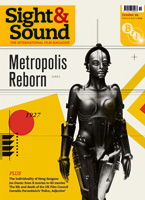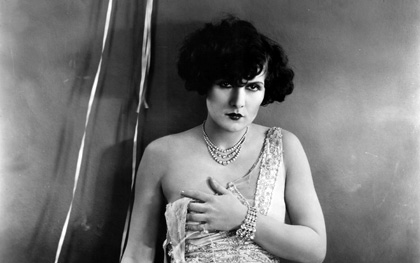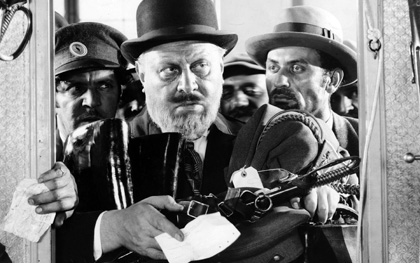Primary navigation

US 1927

Reviewed by Michael Atkinson
Before talkies, before Dietrich, Josef von Sternberg was a master of silent film-making, writes Michael Atkinson
3 Silent Classics by Josef von Sternberg:
Underworld / The Last Command /
The Docks of New York (pictured)
Josef von Sternberg; US 1927/28/28; Criterion / Region 1 NTSC; 81/88/75 minutes; Aspect Ratio 1.33:1; Features: alternate scores, archival interviews, new written and ‘visual’ essays, original Ben Hecht story for Underworld
Josef von Sternberg is one of those auteurs we thought we had pegged – as Dietrich’s svengali, as a petulant arch-expressionist wrestling with the studio system, as the artist who turned his ambiguous ardour for Marlene into absurd, campy sandcastles of light and fetishised iconicity, and then wandered in the desert without her, creating dark fantasias out of lurid genre films (The Shanghai Gesture, Macao) that remain fascinating because of their wild wrongness. And we did peg him, as far as it goes. A full-on critical biography has yet to be written (the new edition of John Baxter’s book is due this autumn and it may surprise us), but should it ever be done right, the picture may change. Perhaps the Dietrich movies – which are slow and arch and extremely, knowingly silly – were a departure for von Sternberg, who’d already worked on 13 movies before he met Dietrich, and who may’ve been first and foremost a silent film director. Looking at the new Criterion box of long-unavailable silents made on the cusp of the sound era, you can’t help but think something was lost for von Sternberg with the coming of talkies.
This isn’t unusual, given the nimbus that still lingers over the 1927-29 window, when it seems that 50 per cent of the greatest silent films, and therefore the greatest films, period, were released, as if they were being rapped out in a pressurised creative flush before the apocalypse descended. Now we can add von Sternberg to that magic-hour catalogue (alongside Dreyer, Lang, Gance, Murnau, Borzage, Pabst, Vertov, Keaton, von Stroheim, Vidor, etc), where previously his half-decade before The Blue Angel was often regarded as apprentice time, years he spent learning what he might do once he met the perfectly photographable woman.
It’s nonsense, because Underworld (1927), The Last Command (1928) and The Docks of New York (1928) are as richly shadowed and ornately crafted as the film-maker’s sound films, and were recognised (and Oscar-awarded) as being exceptionally beautiful and atmospheric works in their day. There’s no getting around von Sternberg’s lavish achievements with mise en scène; either his shadowy urbanscapes feel genuine, with depths and dimensions we cannot see, or they’re as crazily expressionistic as a Caligari doorway. Often, as in the sound films, von Sternberg’s spatial powers take hold in an elaborately designed and outfitted bar or café – as critics have duly noted, it becomes under his hand a three-dimensional metaphor for the daydream fish tank of movies themselves.

Underworld
The real difference is in the films’ seriousness. Whereas von Sternberg’s sound films were pulpily outrageous and often seemed contrived only to place Dietrich in the most preposterously clichéd situations, and then to love her with the camera anyway, these silents are nuanced, speedy, gravely emotional and respectful of their characters to a degree any von Sternbergian might find shocking. ‘Underworld’ may’ve been the first out-and-out American gangster film (co-written by Ben Hecht and Howard Hawks, among others) but it also pioneered a certain Romantic, lower-depths vision of American urban life (one extrapolated on generations later by the likes of Charles Bukowsi, Lou Reed, etc), and also hones in masterfully on character textures as Renoir did only in his sound films. The story – a bank robber and an alcoholic intellectual bond and prosper in the dark universe of nightclubs and back alleys, and a woman comes between them – may seem boilerplate but the nuances are everything: how George Bancroft’s hulking crook, hiding from the cops, dips his finger in milk and lets a mewling cat lick it to keep it quiet. Or earlier, the cool ballet micro-orchestration of dragging on a cigarette, dousing it in champagne ice as he pulls a gun from his jacket, and covers the gun with a napkin as he exhales…
The upshot here is that von Sternberg achieved not only a dazzling environmental assault, as we’d expect him to, but also a degree of eloquence and mature observation that seemed to largely evaporate once the microphones invaded his set. This is true of acting, too – Dietrich’s slow-motion goddess act notwithstanding, von Sternberg’s sound films haven’t revealed him to be a great actor’s director, but in these silents, enormous naturalistic care is taken, particularly with the Alec Baldwin-esque Bancroft, who is utterly convincing as a ship stoker in The Docks of New York (you get a sense of how to do the job yourself when he’s through). A sad sort of Manhattan anti-romance, this melodrama is brimming with genuine tragedy (the kind rooted in character, not incident) and has von Sternberg finding new ways to say things without saying them. When Betty Compson’s seaside tramp, impulse-married to Bancroft but watching him go to sea again, tries to thread a needle, we cut to a close-up of her hands that slowly fogs with tears. Von Sternberg’s use of pregnant close-ups feels very New Wave, but watch the actors respond and wait for each other, and it may be the first time you’ve seen perfectly believable performances in a Hollywood silent.

The Last Command
The Last Command is the freak, because it isn’t pulp, but a deeply strange Hollywood tale, about the production of a film quite like The Last Command, for which a retired, traumatised Tsarist general (Oscar-winner Emil Jannings) is recruited by the émigré director (William Powell) he persecuted years before. It’s a set-up pulsing with resonance, and the most textually loaded manifestation of Jannings’ patented humiliated-man routine. Dead-eyed and foggy, Jannings’ vacated majesty has never been more hypnotic (his spent, penniless has-been even has a palsy head shake), but then the film leaps into a lengthy flashback, which is nothing less than the stylised Russian Revolution film Guy Maddin always wanted to make, turning Eisenstein’s October, released a year earlier, inside out. Based roughly on the real, post-revolution, film-extra studio career of one General Lodijensky, the movie is apolitical, and ends on an unlikely note of rueful honour. But it’s also really a residual love story, lost in the war.
The films are typically Criterion gorgeous up and down, with the predictably fascinating array of supplements on each, including, thank heavens, Alloy Orchestra scores and essays by Geoffrey O’Brien and Luc Sante.
Von Sternberg: six chapters in search of an auteur: David Thompson celebrates the master of light and his six collaborations with Marlene Dietrich (January 2010)
Inflammable desires: Tony Rayns on Kenneth Anger's Magick Lantern Cycle (July 2009)
Starmaker: Gwenda Young on MGM mainstay Clarence Brown, Garbo's favourite director (April 2003)
The smouldering screen: Kevin Brownlow on the lustre of nitrate (online, July 2010)